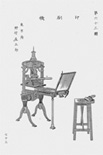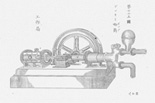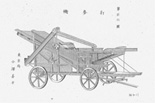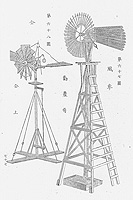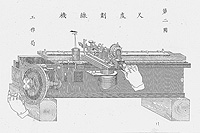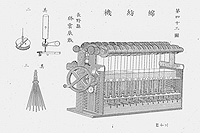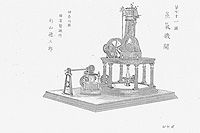(1) Beginning of the National Industrial Exhibitions
In the Edo period, the concept of expositions had yet not been introduced to Japan. During that period, events were held such as medicine fairs and herb markets, where visitors observed displayed items. The purpose of such events tended to focus on the chance to observe something unusual. At the end of the Edo period, however, some feudal domains began to attempt Western-style iron & steel making and shipbuilding, followed by the import of machinery from foreign countries.
In the Meiji period, as part of a policy for the development of national prosperity and military strength, as well as the promotion of industries, National Industrial Exhibitions began to be held to introduce Western technologies and encourage competition and growth among domestic industries. With an emphasis on the promotion of industries, such events were held under the leadership of the Japanese government. Every time a National Industrial Exhibition was held, the event drew more exhibits from the private sector. Technology transfer from Western countries was carried out through full importation of machinery and facilities, the production of imitations of foreign products while watching given samples, and the creation of new Japanese versions through the combination of Western technologies and contemporaneous technologies in Japan. Such movements were reflected in exhibits of National Industrial Exhibitions. The exhibits were initially technically immature. At the fifth National Industrial Exhibition, however, the founders of renowned companies that exist today exhibited their items.
This part provides some exhibit illustrations included in the exposition reports, as well as explanations of such illustrations. Not all inventions regarded as significant today were exhibited at National Industrial Exhibitions. However, it is interesting to know that, along with the development of machinery, the mainstream of exhibited items underwent a shift, and the machinery categories themselves also changed.
First National Industrial Exhibition, 1877, Tokyo
The first National Industrial Exhibition was held only three years after the establishment of the Kangyo-ryo (Industrial Bureau) of the Naimu-sho (Home Dept.) (1874), which was responsible for industrial promotion. Most of the items were exhibited by the government. To draw many domestic exhibits in a short period of time, the government enacted the Shuppinnin Joseiho (exhibitor aid law) to provide support for transportation and other activities. The exhibits were displayed by prefecture in order to stimulate a sense of rivalry between the exhibitors.
For foreign products, only items purchased by the government were exhibited. (This restriction continued until the fourth National Industrial Exhibition.) Featured items included windmills and metallic agricultural implements exhibited by the Kanno-kyoku (Agricultural Bureau) of the Naimu-sho.
Also, imitations of foreign sewing machines and printing presses were exhibited. They were copied based on dismantled foreign products.
Of particular note was the exhibition of products featuring appropriate integration of Western technologies into Japanese industries. Such products included lathes by the Kosaku-kyoku (Building and Manufacturing Bureau) of the Kobu-sho (Dept. of Public Works) and a wooden Jacquard loom by Kohei Araki of Nishijin, Kyoto. Also noteworthy were exhibits by persons who had learned technologies at the Vienna International Exposition. One such example was a linear dividing machine (a machine for marking a scale with degrees) created by Tsuneoki Fujishima, who had learned measurement skills. He made the machine while at the Kosaku-kyoku. Meanwhile, some products, such as a spinning machine (gara-bo) by Tatchi Gaun, were derived from a native Japanese industry. Since this machine could be used without changing the existing cotton thread production system, it rapidly came into wide use.
The majority of the exhibits were items related to spinning and agriculture. In the category of agricultural machinery, a tobacco cutting machine and a seeding machine by Heisuke Kamimura were highly valued in that they saved a great deal of manual labor. However, due to their high cost, they did not come into wide use.
In the category of prime movers, which were regarded as the foundations of industrial growth, a steam engine exhibited by Tokusaburo Sugiyama of Yokohama Iron and Steel Works won second prize. However, some people thought that the engine was not appropriate for practical use. With consideration of the fact that the use of hydraulic power was still active even in foreign countries, efforts were focused on the utilization of such power in Japan as well, a country endowed with rich water resources.
At the first National Industrial Exhibition, domestic products were merely at the level of imitation and improvement of foreign products.
Exhibits of the first National Industrial Exhibition
Section 4: Machinery Exhibits
| Category | Machinery | No. of Exhibits | Image |
|---|---|---|---|
| 1 | Chemistry | 4 | - |
| 2 | Machine Tools | 26 | 5 |
| 3 | Spinning and Weaving | 63 | 35 |
| 4 | Sewing | 3 | 2 |
| 5 | Leather Works | 0 | - |
| 6 | Watches | 0 | - |
| 7 | Jewelry | 0 | - |
| 8 | Printing | 3 | 1 |
| 9 | Power Generation | 10 | 8 |
| 10 | Pumping | 25 | 6 |
| 11 | Fire Extinguishing | 16 | - |
| 12 | Brewing | 1 | - |
| 13 | Diving | 0 | - |
| 14 | Ice Making | 1 | 1 |
| 15 | Railroad | 0 | - |
| 16 | Agricultural Production | 51 | 25 |
| 17 | Transportation | 8 | - |
| Total | 211 | 83 |
|
- Source:
-
Meiji junen naikoku kangyo hakurankai hokokusho(Naikoku kangyo hakurankai, 1878)
- Reference:


